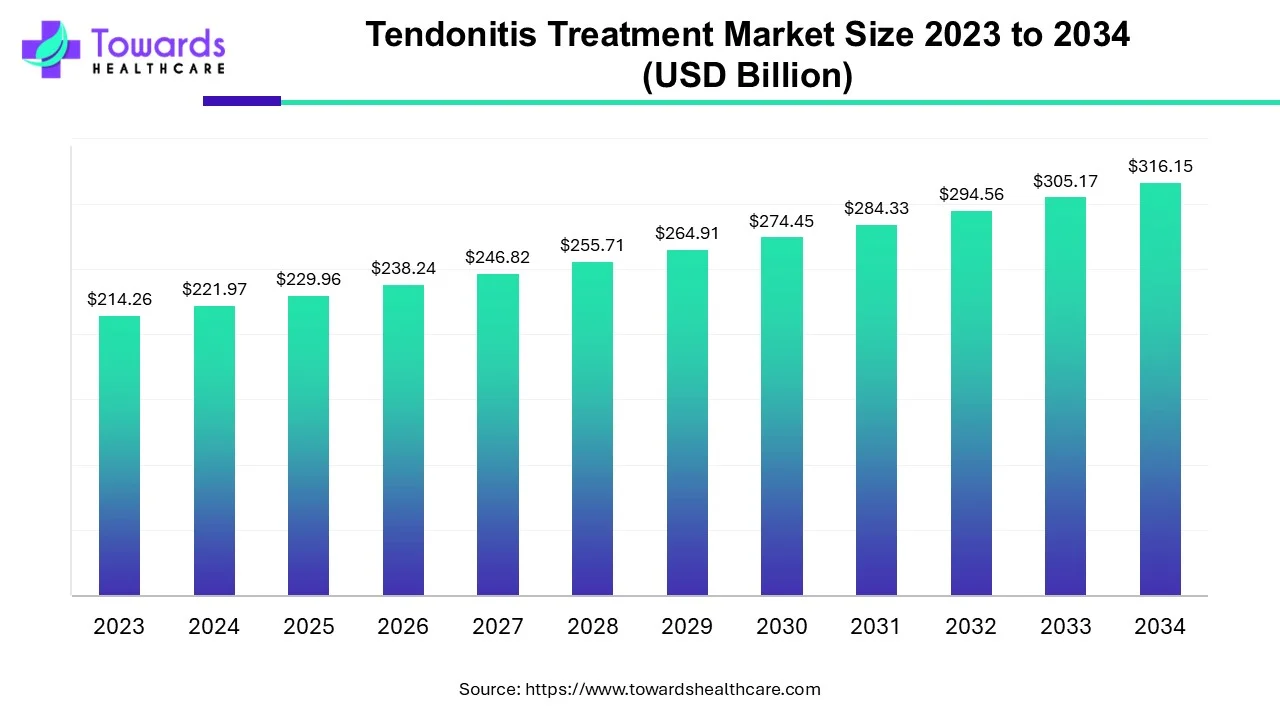Tendonitis Treatment Market Growth and Outlook (2024 – 2032)
The global tendonitis treatment market is expected to expand significantly, growing from USD 214.26 billion in 2023 to approximately USD 298.14 billion by 2032. This growth reflects a compound annual growth rate (CAGR) of 3.6% during the forecast period from 2024 to 2032.

Download statistics of this report @ https://www.towardshealthcare.com/download-statistics/5135
Report Highlights:
- In 2023, therapies accounted for 65% of the tendonitis treatment market, making them the most preferred approach.
- Medications held a 25% market share in 2023.
- North America led the market, capturing 42% of the share.
- Over 70,000 Americans miss work each year due to tendonitis, according to the Bureau of Labor Statistics, with this number continuing to rise, highlighting the growing need for improved treatment options.
Understanding Tendonitis
Tendonitis is an inflammation of the tendons, the connective tissue between muscles and bones. Imagine your body as a well-coordinated team, where muscles and tendons work together seamlessly. In tendonitis, however, the tendons become strained, leading to pain. The condition most commonly affects the shoulders, elbows, wrists, knees, and heels.
The Impact of Repetitive Movements
Occupational activities involving repetitive motions and physical strain are major contributors to tendonitis. Jobs such as typing, assembly line work, and manual labor can place constant stress on specific tendons, which over time may lead to inflammation and injury. This strain increases the demand for tendonitis treatments.
Workers in industries like construction, manufacturing, and data entry are especially vulnerable, as their daily tasks involve repetitive movements that can deplete the tendons. The growing number of individuals exposed to these risks has led to an increased need for treatments, ranging from basic rest and physical therapy to more advanced interventions.
Preventative Measures in the Workplace
Regular breaks are essential for recovery, as they allow the body time to heal. Short pauses during work, combined with stretching or changing positions, can help prevent muscle overuse and reduce strain on tendons. Stretching exercises, particularly those targeting areas prone to tendonitis, are beneficial, while strengthening exercises can provide better muscle support to protect the tendons.
Employers play a key role in promoting a healthy work environment by providing ergonomic tools, conducting training on proper practices, and fostering a culture focused on employee well-being. Early intervention is crucial for preventing more serious issues—if tendonitis symptoms appear, seeking medical advice, using ice or heat therapy, and adjusting work tasks can help speed recovery.
Recent Developments
- In April 2022, Boehringer Ingelheim launched RenuTrend, a novel treatment for tendon and ligament injuries in horses. Administered via injection directly into the affected area, it’s the first of its kind in Europe, complementing the company’s existing stem cell treatments for horses.
- In September 2021, Stryker introduced the Citrelock Tendon Fixation Device System, which aids in repairing damaged tendons without further injury. The system uses a specialized thread made from materials like citrate, calcium, and phosphate, which support bone healing.
Our Table of Content (TOC) covers key healthcare market segments, materials, technologies and trends—helping you navigate market shifts and make informed decisions: https://www.towardshealthcare.com/table-of-content/tendonitis-treatment-market-sizing
Access exclusive insight now @ https://www.towardshealthcare.com/price/5135
We’ve prepared a service to support you. Please feel free to contact us at sales@towardshealthcare.com
Web: https://www.towardshealthcare.com
Visit Dental Specifics: https://www.towardsdental.com
Get the latest insights on industry segmentation with our Annual Membership: Get a Subscription
For Latest Update Follow Us: https://www.linkedin.com/company/towards-healthcare


